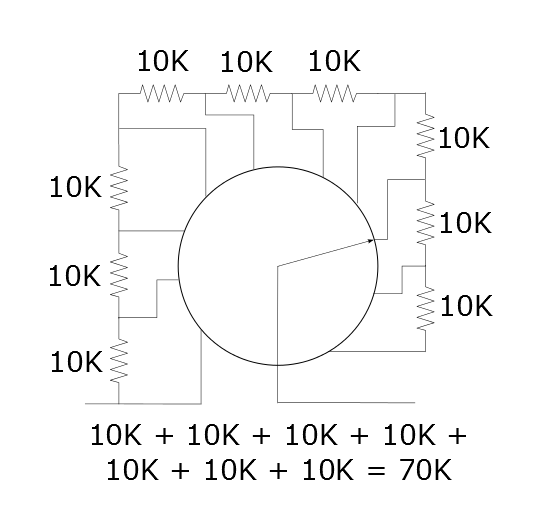Decade Resistance Box Hookup Guide
How It Works
Resistors placed in series are additive. If we connect resistors end-to-end, the overall resistance is the sum of the values. Below, we see that we can make a 43K resistor by adding a 10K to a 33K.
The decade box employs this principle. Each decade is a string of the the same value resistor. A rotary switch is used to select the point in the string that corresponds to the desired value.
Each rotary switch has 10 positions, from 0 to 9. The 0 position simply shorts the switch input to it's output, and each successive position adds one more resistor to the chain. A switch can go between 0 and 9 times the decade value. If we need 10 times or greater the value, we move on to the next decade.
The decades are arranged in series, as well. The tens control feeds the hundreds control, and so on.
Constraints
Before we move on to some example applications of the decade resistance, let's take a closer look at the components, because they place some limits on the decade box.
With modern, low-voltage electronics, we often operate under the assumption that we aren't using much power, or passing much current. Sometimes we are reminded of the power or current involved when things heat up, reset mysteriously, start to smell hot, or catch fire.
To help avoid those situations, let's explore the main constraints of the decade resistance.
Resistors
The first place to look is the resistors. The resistors are rated to dissipate up to 1/4 W each. This might not seem like much, but for many circuits, it's a reasonable upper limit. Let's examine the reasons a little more closely.
We know that power in Watts is calculated using.
P = IV If we don't know the Voltage or Current terms, but we do know the resistance, we can substitute Ohm's law in for the missing I or V term, resulting in
P = (V^2)/R P = (I^2) * R We'll take a shortcut, and assume that the maximum voltage across the decade resistance is the difference between the positive and negative supply rails. For some common supply voltages, we'll calculate the resistance that draws 1/4W.
| Supply Voltage | R that draws 1/4W | Current Through R at 1/4W |
| 3.3V | 43.56 Ω | 75 mA |
| 5V | 100 Ω | 50 mA |
| 9V | 324 Ω | 27 mA |
| 12V | 576 Ω | 20 mA |
| 30V (+/- 15V supply) | 3600 Ω | 8 mA |
This table can serve as a guideline for applying the decade resistance. For a circuit powered by a given voltage, the "R that draws 1/4W" column indicates the resistance below which you need to consider the power drawn by the box.
But this is a guideline, and not a hard rule. Some circuits use high voltage supplies, but don't put the full voltage across the decade box.
Switches
Additionally, the manufacturer states that the rotary switches are limited to passing 300 mA.
To Summarize
If you find yourself dialing in resistances below 500 Ohms, take a moment to work out how much power you'll be dissipating, and current you'll be drawing. The maximum limits for the decade box are overall power dissipation of 1/4 Watt, and the current passed of 300 mA. If you're unsure, you can always use an Ammeter in series with the Decade Resistance to verify the current draw.
If you need help calculating the power dissipation, check out our power tutorial. The multimeter tutorial describes how to measure the current drawn by a circuit.

